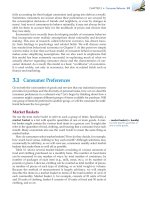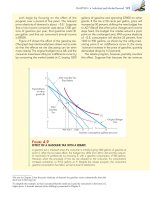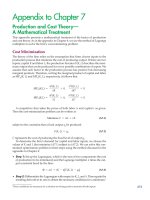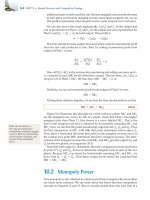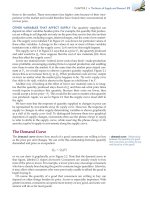(8th edition) (the pearson series in economics) robert pindyck, daniel rubinfeld microecon 120
Bạn đang xem bản rút gọn của tài liệu. Xem và tải ngay bản đầy đủ của tài liệu tại đây (140.33 KB, 1 trang )
CHAPTER 3 • Consumer Behavior 95
therefore makes Roberta better off. (Note that B is
also preferred to C, which represents the option of
not using the health club at all.)
We could also ask whether this new pricing
system—called a two-part tariff—will increase the
club’s profits. If all members are like Roberta and
Other
recreational 100
activities
($)
80
60
40
more use generates more profit, then the answer
is yes. In general, however, the answer depends on
two factors: the preferences of all members and the
costs of operating the facility. We discuss the twopart tariff in detail in Chapter 11, where we study
ways in which firms with market power set prices.
C
F IGURE 3.20
REVEALED PREFERENCE
FOR RECREATION
A
B
U1
U2
20
l1
0
25
l2
When facing budget line l1, an individual chooses to
use a health club for 10 hours per week at point A.
When the fees are altered, she faces budget line l2.
She is then made better off because market basket
A can still be purchased, as can market basket B,
which lies on a higher indifference curve.
50
75
Amount of exercise (hours)
3.5 Marginal Utility and Consumer Choice
In Section 3.3, we showed graphically how a consumer can maximize his or
her satisfaction, given a budget constraint. We do this by finding the highest
indifference curve that can be reached, given that budget constraint. Because
the highest indifference curve also has the highest attainable level of utility, it is
natural to recast the consumer’s problem as one of maximizing utility subject to
a budget constraint.
The concept of utility can also be used to recast our analysis in a way that
provides additional insight. To begin, let’s distinguish between the total utility
obtained by consumption and the satisfaction obtained from the last item
consumed. Marginal utility (MU) measures the additional satisfaction obtained
from consuming one additional unit of a good. For example, the marginal utility
associated with a consumption increase from 0 to 1 unit of food might be 9;
from 1 to 2, it might be 7; from 2 to 3, it might be 5.
These numbers imply that the consumer has diminishing marginal utility:
As more and more of a good is consumed, consuming additional amounts
will yield smaller and smaller additions to utility. Imagine, for example, the
consumption of television: Marginal utility might fall after the second or third
hour and could become very small after the fourth or fifth hour of viewing.
We can relate the concept of marginal utility to the consumer ’s
utility-maximization problem in the following way. Consider a small movement
• marginal utility (MU)
Additional satisfaction obtained
from consuming one additional
unit of a good.
• diminishing marginal utility
Principle that as more of a good
is consumed, the consumption
of additional amounts will yield
smaller additions to utility.

